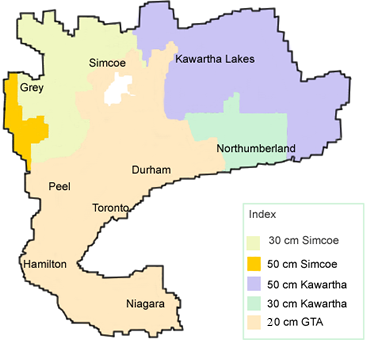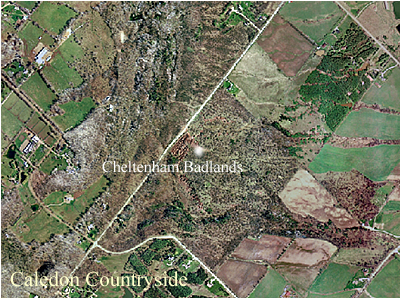Description
These digital orthoimages provide full-colour aerial coverage of the Greater Toronto Area, Golden Horseshoe and other counties including Grey, Simcoe, and Kawartha Lakes. There is also separate coverage of Lambton County (west of Middlesex County). These images were flown in April 2002 by J. D. Barnes and provided to the Geospatial Centre by the Ministry of Natural Resources in October 2004. The 5-colour map below outlines the extent of the area for which these images are available and also illustrates the range in pixel resolution from 20 cm to 50 cm.
Please note that because not all the images are held locally, some must be downloaded from a remote server in Toronto. A detailed index of 2002 Ontario Golden Horseshoe Orthophotos, prepared by the staff of the Brock University Map Library, provides the 11-digit tile identifier (e.g., 17 6320 48580) for each image. Please use this index to determine the tile identifiers for the images that interest you.

Spatial reference and data type
These georeferenced images are available in Universal Transverse Mercator (UTM) coordinates; horizontal datum is North American Datum (NAD) 83. They are stored as compressed MrSID data files, with accompanying Sid World (SDW) files. Average file size for a MrSID image is 4 MB.
Data access
In order to access these data sets, please visit the Geospatial Centre reference desk during reference hours. Library reference staff are available to provide further information about these data sets and to deliver data upon request. Under the terms of the Library's license agreement, these data sets are for use by students, faculty, and staff at the University of Waterloo only.
Data manipulation and storage
There are public workstations in the Geospatial Centre that provide access to both ArcGIS and ArcView software programs, program extensions and data manipulation utilities. Patrons may use the Geographic Information System (GIS) and image processing software in the library to view and manipulate the data. UWaterloo faculty, students and staff may copy these data for use elsewhere.
Data output
These images may be exported from ArcGIS in a choice of bitmapped formats (also known as raster graphics) including JPG, TIFF, GIF, and BMP or in a choice of vector graphics formats including Adobe Illustrator (AI), Encapsulated Postscript (EPS), and Scalable Vector Graphics (SVG). Yet another option is PDF. The user defines the output resolution.
Use restrictions/licensing/copyright
These data are provided for personal use for academic, research, and/or teaching purposes. A data release agreement must be agreed to before these licensed data can be released. The Ministry of Natural Resources must be acknowledged on any derivative product, whether printed or electronic, including for example, a printed map, a raster or vector graphic, a web-based application, etc. Patrons are advised to fully respect the provisions of Canada's Copyright Act as well as terms and conditions imposed by the data provider.
Citation
GTA and Adjacent Regions : orthoimagery 2002 [computer file]. Toronto, Ontario: The Ontario Ministry of Natural Resources, [2002].
Sample view of the data

Data courtesy of the Ontario Ministry of Natural Resources